25 July 2024 |
By - Sudha Mariappan
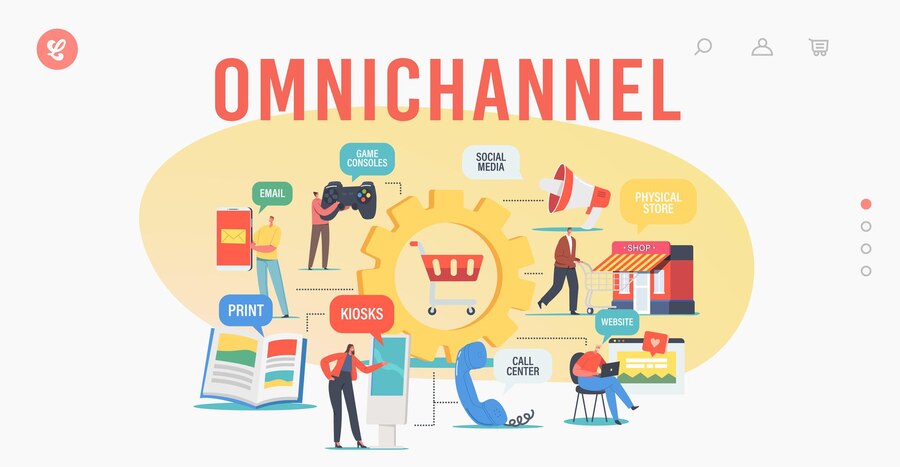
Today, omnichannel has turned into a naturally essential strategy for brands that strive to create a smooth and coherent customer experience.
Basically, an omnichannel marketing strategy is nothing but promoting your brand across various channels, which include social media platforms, websites, email and even offline events such as retail stores.
Several brands have successfully launched omnichannel marketing into their platforms. Having said that, from high-end brands to small brands have managed to establish and implement their respective omnichannel strategies to engage with customers.
Let us take a look through this blog at some really innovative and real-life examples of effective omnichannel marketing done by Indian brands.
Understanding Omnichannel Marketing:
Before we delve into brands that use omnichannel marketing, we need to have a basic understanding of what is meant by omnichannel marketing.
Omnichannel marketing is simply the use of many channels of communication so customers experience one continuous activity, be it offline or online, as mentioned above.
It's not just being on many channels but ensuring brands give customers a unified message and experience at each stage they are in interacting with the brand.
For example, if you own a coffee brand, you need to promote your brand on social media. When your customers discover your shop through social media, they’ll be directed to your website, where they’ll find hot coffee of the day or deals of the day. After that, they will reach your store for coffee.
Omnichannel marketing refers to when a brand designs a continuous and uniform experience across all the various ways that a customer can engage a brand. In this example, your customer gets a unified experience by knowing about your coffee shop through social media, knowing about your coffee deals through your website, and finally entering your coffee shop.
Now, let us break this down in detail:
1. Multiple Channels, One Experience:
What are Channels? Channels are the means through which customers can reach out to a brand. This would mean physical stores, websites, mobile apps, social media, email, customer service lines, even chatbots.
Why are there so many Channels? Today's customer uses many diversified ways to engage with the brand. For example, a person might start shopping on a website, ask a question on social media, and then later visit the store to make a purchase.
2. Has a Unified Experience:
All of these different engagements are tied together in omnichannel marketing. In other words, it is consistent in-store and online experiences that help engage with a customer. If a customer adds something to their cart on a mobile app, they should be able to log in on a desktop computer and see it in their cart.
This means that the brand message, look, and feel are consistent across channels. Be it their ad on Instagram, scrolling on their website, or walking into a store, everything is cohesive and familiar.
In this, omnichannel marketing uses customer data to understand their behavior and preference. For example, a customer purchasing sports equipment quite frequently will receive highly personalized recommendations about new sports products, mostly online.
The idea is to make a customer feel recognized and valued at each touch-point with the brand. This could be in the form of personalized offers sent via email or even a sales associate in the store knowing about your online purchases.
4. Cross-Channel Integration:
Customers can easily move across channels in omnichannel marketing. For example, you can read reviews of the product on the Internet, order it using the app, and then select in-store pickup.
Through connected data, brands remember what you've done and how you’ve communicated, so you don't have to communicate again and again. For example, if you tweet a question to customer service, the support staff will already know what your concern is.
5. Improved Customer Journey:
Improved customer journeys develop long-lasting relationships with customers whereby value created in every touch point paves the way for them to much more likely return and be loyal to the brand.
Why Is Omnichannel Marketing Important?
Brands only have one concern: reaching out to customers. Quite simply, omnichannel marketing is significant because it reaches consumers wherever they are. Customers want the brands they do business with to be present and responsive on a number of platforms today. By integrating that experience and making it smooth, a business can facilitate customer satisfaction and increase brand loyalty, ultimately leading to more sales.
Brands that have effectively used Omnichannel Marketing:
Now let’s see how brands have taken omnichannel marketing to their advantage:
1. Tata CliQ:
Tata CliQ is one of the prime e-commerce brands in India, making it the country's best example of having successfully blurred the lines between online websites and offline stores to create an omnichannel marketing mix in the retail sector.
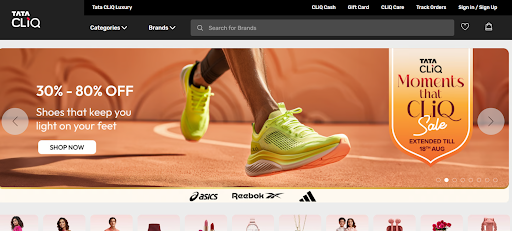
Omnichannel Strategy of Tata CliQ:
Phygital Experience: Tata CliQ has started their online platform with offline retail stores. Their motive was to create a unique experience for customers to get the "phygital" (physical + digital) taste of shopping. This implies that customers can check out a product online, select an option to pick it up from a store near them, or try on the product before purchase.
CliQ & PIQ: In this facility provided by this brand, customers could order their required products online and pick them up after at their convenience from a physical store. This will ensure that there will be consistency and seamlessness between these two types of shopping experiences, offline and online.
“Tata CLiQ was the true embodiment of omnichannel presence, as anyone can buy a product from Tata CLiQ and simply return or exchange it by visiting the store of the product, and even redeem the money back.” As said by Pravesh Kaushik – Business Head, Apparel – Tata CLiQ, quote taken from Apparel Resources.
Tata CliQ uses one customer data platform to unify customer preferences and shopping behavior across all channels, so the recommendations will be consistent.
This strategy has enabled Tata CliQ to further up their satisfaction and loyalty levels by delivering a seamlessly very convenient shopping experience. It has also bridged the gap between the two worlds of online and offline shopping into one single platform, which adds to making it a one-stop destination for the different needs of Indian customers.
2. Domino's:
For years, Domino's has been at the forefront of adopting digital strategies so as to make sure the best of the experiences for their customers. This omnichannel approach makes it possible for customers to order their favorite pizzas from anywhere and at any time with minimum friction.

Omnichannel Strategy of Domino’s:
Multiple Ordering Channels is a feature where Domino's has an edge over its competitors. This feature allows potential customers to order through Domino's website, mobile app, call center, SMS, or even through social media apps such as Facebook Messenger.
- The brand is very well integrated across all these platforms, and customers have a smooth interface, no matter through which platform the order is placed.
- Also, Domino's incorporates the use of multi-channel real-time data to enable smooth delivery operations with the continued assurance of delivery being made in a span of 30 minutes after an order has been placed from.
- The leading Domino's loyalty program called Domino's Pizza Mania is also integrated across various channels for customers to be able to earn and redeem whatever order is placed.
The omnichannel strategy of Domino's has literally helped them jolt up their customer retention and customer satisfaction. This has been a prime reason why the brand is one of the most picked pizza brands in India now. The real experience of a connected world without dropping the essence of their brand has knitted them together at all the touchpoints possible.
3. Nykaa:
Nykaa is a premium beauty and wellness platform in India that has adopted an omnichannel strategy to reach its diversified customer base.
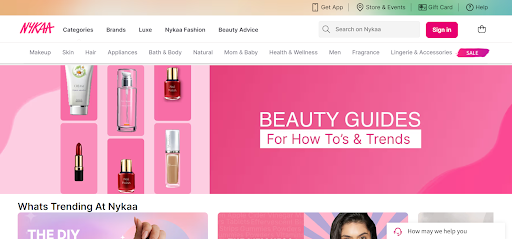
Omnichannel Strategy of Nykaa:
Even though it started as an online platform, Nykaa has set up shop with brick-and-mortar retail outlets all over India. This online to offline approach, or O2O has afforded customers the freedom to look for a product online and purchase it in person at a retailer or vice versa. Nykaa even has a 'click and collect' service where a customer can order online and collect from a store.
Nykaa develops personalized product recommendations, offers, and content from customer data captured from online and offline interactions. Its mobile application, website, and physical stores work in sync to deliver a consistent customer experience.
To further close the loop between online and offline shopping experience, Nykaa initiated "Nykaa Virtual Try-On", which provides customers with a view of lipstick and eye shadows on their face even while surfing.
Thanks to their omnichannel approach, now Nykaa has quickly grown and succeeded. With their online and offline experiences, Nykaa has been able to build a large consumer base, focusing on the convenience and specialization experience that it offers the customer.
4. Shoppers Stop:
Shoppers Stop is probably one of the oldest, highly reputed retail chains in India. Through its Omnichannel Strategy, Shoppers Stop has brought together a chain of shopping across both digital and physical interfaces.

Retailers like Shoppers Stop also provide an "Endless Aisle" service, allowing customers to browse and buy products online from its total collection while standing in physical stores. In case of unavailability in specific stores, any product can always be ordered online to be delivered to homes or picked up at any store.
They have a loyalty program as part of the brand's omnichannel strategy, where customers can earn and redeem the points on online as well as offline transactions for each of their purchases.
The ability for a customer to shop online and collect a purchase in-store nearby is a set of service offerings that Shoppers Stop is able to support.
The omnichannel approach by Shoppers Stop equals high customer satisfaction, ensuring that the shopping experience is consistent across all digital and physical channels. An integrated feature of loyalty programs with services like “Click & Collect” has built a loyal customer base and made a lot of customers visit offline stores.
5. Pepperfry:
Being a furniture retailer online, Pepperfry leads its segment in India and has used an omnichannel approach to meet the special needs of furniture shoppers who will generally prefer to see and feel a product first before buying.
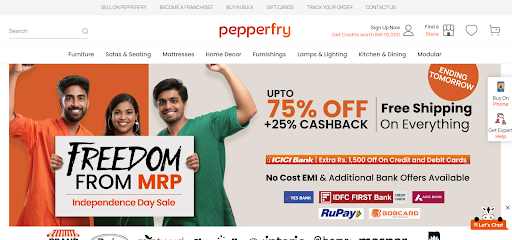
Omnichannel Strategy of Pepperfry:
- Studio Pepperfry: The company has a chain of offline experience centers, Studio Pepperfry, across all major cities in India. In this way, a customer is able to get an idea about what the furniture will look like. Moreover, orders can be placed at the studio or directly via the Pepperfry App/Website.
- Augmented Reality (AR): The application of Pepperfry uses AR technology, by which customers are able to see how a piece of furniture would look in their home. This integration of digital tools is done so the offline shopping experience would be optimized with ease of customer decisions.
- 24/7 Customer Support: Customer is right at the heart of Pepperfry, so customer support is integrated across all channels. The experience is consistent when a customer queries either online, via telephone, or in the Pepperfry studio.
Pepperfry's omnichannel approach has placed it at the top in the online furniture market. While accomplishing this, the brand has established itself as a perfect blend of digital and physical experience. Pepperfry is a brand which is customer-centric in nature and is improving to be so by catering to the evolving needs of Indian Customers.
6. HDFC Bank:
The largest private bank in India, HDFC Bank has successfully pursued the omnichannel marketing strategy to present a banking experience that is consistent across all touchpoints, both physical and digital.

Omnichannel Strategy of HDFC Bank:
They combined both their digital and Branch Integration. Customers of HDFC Bank can effortlessly move from the online banking platform to the location of its physical branches and vice versa. As an example, one can apply for a loan online and complete the formalities in a branch, or vice versa.
They use a 360-degree view approach to know about their customers. It captures all the interactions across all channels, from mobile apps and internet banking. They also get information from ATMs and branches. Finally with the help of consolidated data, the bank will be able to provide all kinds of customized services and suggestions.
HDFC Bank has announced the launch of WhatsApp Banking for the customers, enabling them to use this messaging channel for doing various banking transactions and queries. The app is aligned with other banking channels to provide a standardized experience.
HDFC Bank's omnichannel strategy helped to improve customer relationships by providing a consistent and convenient experience across the bank's different channels of banking. This strategy has also helped the bank to acquire new customers, and more importantly, to grow in the digitally savvy segment.
7. Big Bazaar:
Big Bazaar, the country's leading hypermarket chain, has adopted an omnichannel approach that meets all the customers' needs. The company has been trying to do ease-of-online shopping and local grocery shopping at one time.
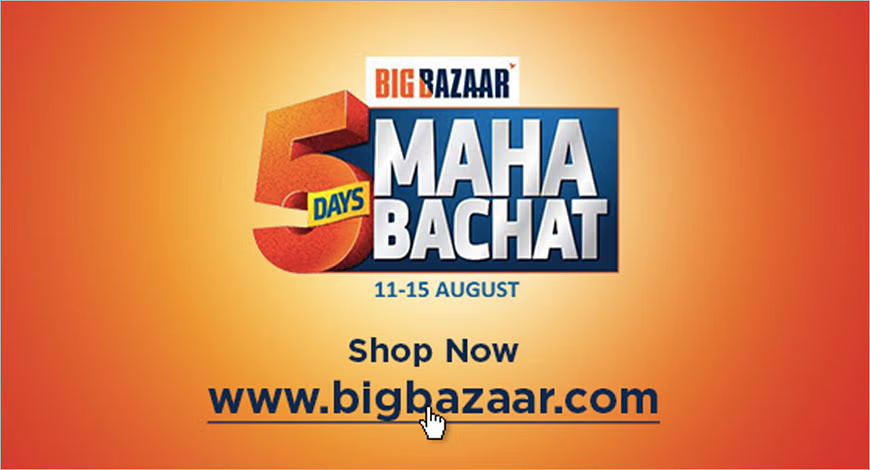
Omnichannel Strategy of Big Bazaar:
Big Bazaar's fashion brand, FBB, has integrated the online platform with the physical store so that the customer has an option of shopping online and collecting it from the nearest store. This bridging allows the customer access to the total package of buying experience, irrespective of the shopping medium they prefer.
Big Bazaar gives a lot of importance to this aspect as a part of its strategy to become an omnichannel retailer. Members get exclusive discounts and offers, valid for shopping through online and in-store purchases, alike in both ways, ensuring a consistent and treasured shopping experience.
Big Bazaar has upped its home delivery scheme wherein one can purchase their essentials and groceries online and get them unboxed at their entryway almost by the time.
The Hyperlocal Omnichannel approach from Big Bazaar gives them a much stronger position in the retail market. It brings flexibility and discontinuity to the customers. With their online and offline servicing, the brand has been able to place itself well among other competitive markets, along with retaining loyal customers.
Conclusion: Using Omnichannel Marketing, your brand can stay ahead and maintain the competitive edge. Top brands such as Nykaa, Domino's, and a few others have shown how well-designed omnichannel strategies can help a brand excel at pleasing customers and craft loyalty, achieving business success in the end.
To reach out to us for how to start implementing some of the winning omnichannel strategies for your brand, you can write to us at info@ontogendigital.com. To keep updated, subscribe to our blog for exclusive insights to all the changes in the field of digital marketing.
KEY TAKEAWAYS:
- Omnichannel is for the purpose of making an uninterrupted experience for the customers across every online and offline channel.
- Indian bands like Tata CliQ and Nykaa have indeed set some outstanding benchmarks with their innovative omnichannel strategies.
- Cross-device integration helps enable customers to switch quickly from one channel or device to another.
- Enhanced customer journeys lead to high satisfaction, and high chances of obtaining permanent loyalty.